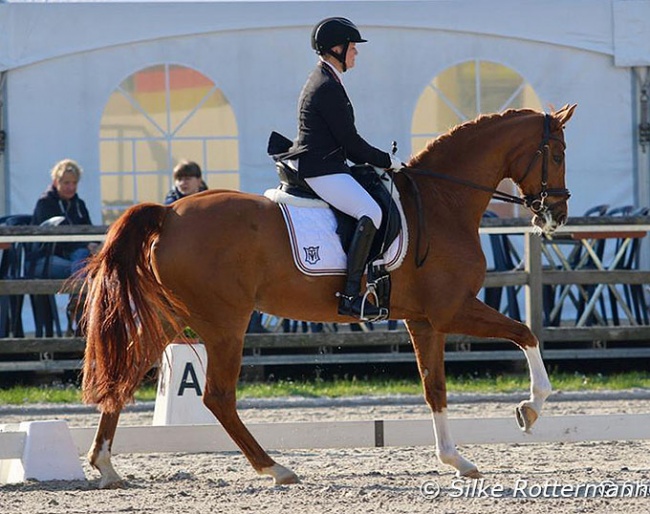
-- this article is a continuation of The Parotid Gland - the Hidden Indicator of Training Quality
When I was a kid, I remember reading Kyra Kyrklund's book Dressage with Kyra a hundred times. In one picture Kyra shows that at least 3 fingers should fit between the atlas joint and the mandible when the horse is standing freely. On the same page there is a horse with visible parotid glands and a short demonstration of anatomy.
I came to think about this page when I prepared this article, as it reminds the riders about a very important anatomical fact. The book says that there must be enough room between the head and the neck, otherwise the parotid gland won’t have enough room and it can be bulged outwards. If the rider still requires the horse to move in such a tight position, it can cause the horse pain and create a conflict between the horse and the rider.

with Kyra' how important it is to recognize
the conformation and its effects
on the frame that is anatomically possible
for the horse (Photos © Jytte Lemkow)
A horse that knows the concept of reaching to the bit in a soft, balanced way is a pleasure to ride and watch. This is an important base of good training practice, and it is a sign of a horse that trusts the rider's hand. In this article we will discuss the elements that are needed to create a horse, that searches the contact in a correct way. Healthy roundness is created from good energy, balance and connection, where the horse himself seeks the contact, that the rider again picks up and uses wisely.
The connection
The horse must be able to trust on the contact and the rider's hand. Only then the reaching towards the bit will happen in a good way. For that we need balance, the horse shouldn’t hurry forward when we give with the rein to ask the horse reach forward.

helps to create the light and gentle reaching feeling towards the
connection that rider softly picks up.
People intuitively tend to react backwards or downwards when the horse lifts his head. This causes problems in the trust. If the horse is resisting the hand, it is not beneficial to argue about the head coming down. You should instead give the horse another idea, take care of forward movement keeping your hands soft and search the relaxation of the poll, jaw, and neck through lateral exercises or a large circle. This helps the horse to relax and trust the hand in the future.
The Balance
A correctly trained horse finds it easy to change the frame when asked to do that. Changing the frame always means a change in the balance, as the horse uses his head and neck to balance his body. The horse must be able to do this change with a soft and relaxed contact. For correct balance it is important that the frame stays in front of the vertical, this should not be compromised.
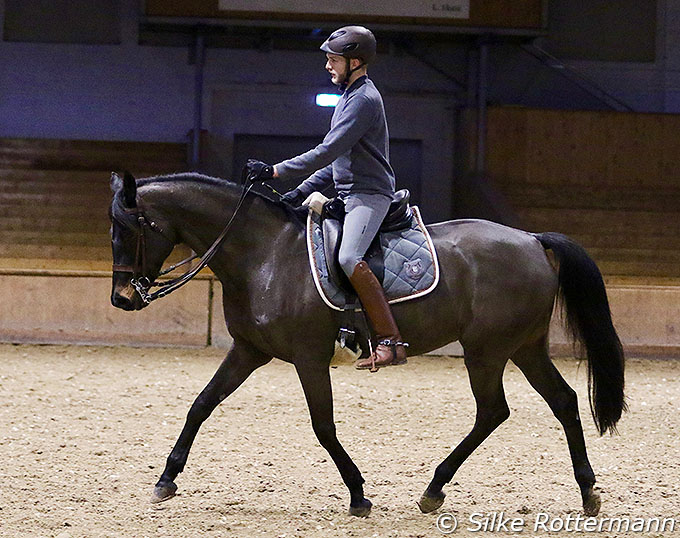
routine between different exercises.
Different kind of exercises help developing the balance, you could say that any exercise well done is useful. Specially transitions, lateral movements, and large curved lines are very useful with different kind of horses when beginning to develop self-carriage with a young horse. It is very common that horses at first try to change their frame in transitions, especially when doing a transition downwards. This is a common situation where riders try to keep the head down. Next time try instead a lateral flexion without using the hand backwards and see what happens when you give with the rein and ask the horse to move forward. Usually the head lifting reduces or disappears quickly.
The frame
The frame is defined in dressage rules very clearly, and using different frames is an important part of training a horse in a classical way. The way the frame is described in the dressage rules is very clear and if the spirit of the rulebook is followed, the well-being of the horse is really on a good path.
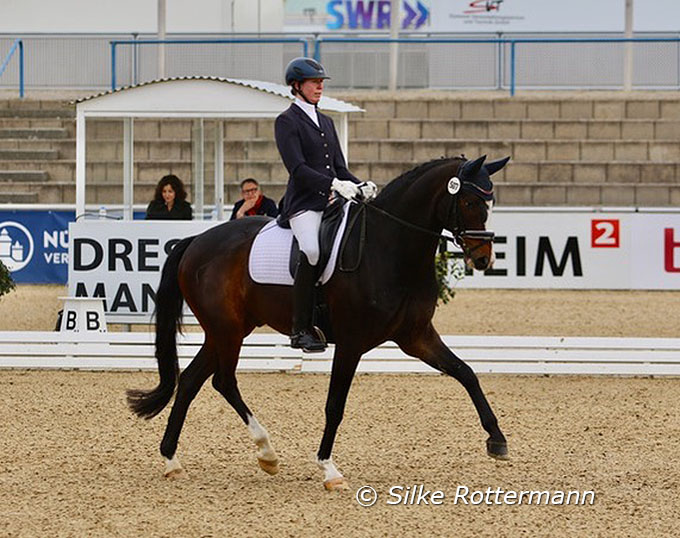
Some trainers allow a “rounder” frame behind the vertical as part of the process, and the others want to keep the horse always in front of the vertical. Personally I believe in learning the horse to keep the frame just in front of the vertical in different frames and postures, because I can’t see any benefit of closing the frame more than that. I don’t find the closed frame being useful for creating the forward and upward reaching feeling I want to have.
The rider needs to feel the difference of having and open or closed frame. If the horse is closing the frame, the rider can easily help the horse to find a better posture by gently lifting the rein once or twice, and then asking the horse to add some activity in the movement while the rider gives a little bit with the hand. This also helps the upper neck area to relax instantly, which again helps with the force transmission.
The energy
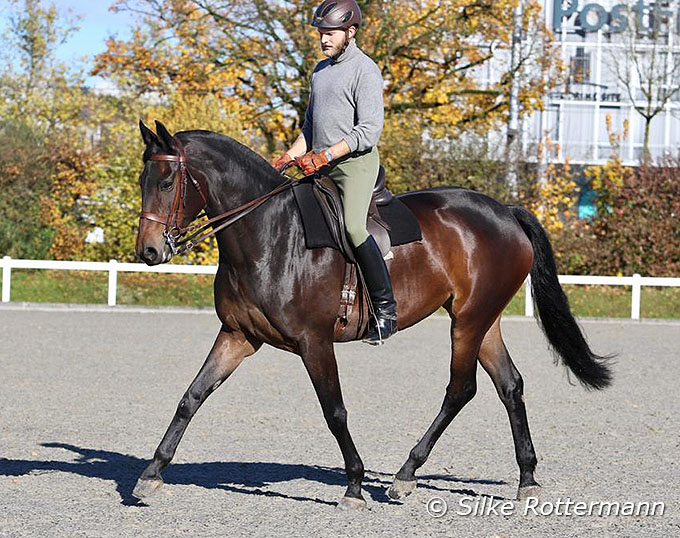
added pressure on the bit
The energy of the hindlegs is most useful if the frame and balance are good. If the horse tries to close the frame or you accidentally asked for this, it’s better to ask the horse to open the frame and then ask again for the energy. A closed or compressed frame creates a delayed front leg protraction, which affects the neck and back muscles and even the pelvic posture. In trot it is common to see the horse still have one front leg in the ground when the horse should already be in the suspension phase. This is usually a result of heavy or tense contact, lack of balance or tension somewhere in the body.
If your horse closes or shortens the frame when asking to move forward, try to soften your fingers, open the frame with a gentle half-halt upwards and then ask again with your leg. Try to feel the difference in the propulsion, it’s there.
The reaching
Some horses suggest a short and contracted frame even when the rider gives the reins away, especially many Iberian horses can easily offer something like this. Some horses have learned the contracted frame because of their training. This kind of frame is not helpful for the communication, breathing, balance or the overall performance health. This kind of horses need a lot of work with a focus on suppleness and in an open frame that can be easily shortened and lengthened without becoming short between the mandible and the atlas joint.

the reins away
If the horse finds reaching to the bit difficult, try to use the hand against the horse's neck and gently push the neck forward to reset the rhythm of neck movement.
Another good way is to create the reaching feeling in trot or canter. This is easiest to do on a large circle with a soft bending and lateral flexion. When the frame feels good and the contact is soft, you can try to give the rein one or two cm towards your horse's ears. Just think of gently touching the corner of the horse's mouth, relax your fingers and add leg aid right away while the rein “softly melts away”. As you do that, you want to find a feeling that the horse is gently searching for the contact you just gave forward. If the horse resists upwards, make sure your lateral flexion was good enough and try to add energy in the movement without being in hurry. You want to feel the push from the hindlegs through the body so that the horse is almost becoming a little longer just behind the ears without putting pressure on the bit.
Being open in a correct way
Sometimes you see horses that move in front of the vertical, but they remain compressed in the frame. If the horse is trained for a longer period of time like this, the parotid glands can be very prominent due to pressure on the area. A frame can be closed both in front of and behind the vertical, both versions are incorrect, and they both produce horses that can have collected tension on the parotid gland area for a longer period of time.
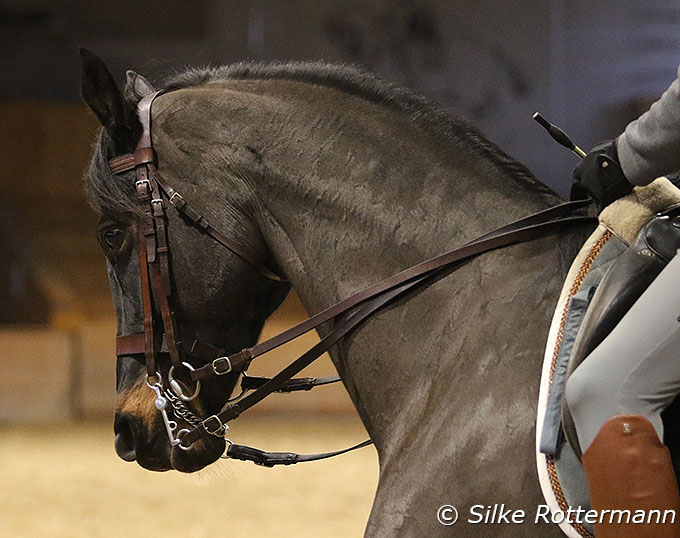
rider still has the feeling of a soft reaching towards
the contact
For good movement we need a lot of variation, it’s part of the movement skills learning process. If you reach and lengthen your neck, you can easier create powerful movement by carrying your body properly as the fascial structures are allowed to glide in a useful and natural way, creating a dynamic dance between loading and release. When the neck and jaw are relaxed and softly reaching to the bit, you can add a lot of energy to the movement without resistance. For this reaching feeling you need a soft hand, a lot of calm energy and good sense of balance.
by Niina Kirjorinne for Eurodressage
Photos © Kirjorinne - Astrid Appels - Silke Rottermann
Sources and related reading
1. Transmission of muscle force to fascia during exercise.
Findley, T., Chaudhry, H., & Dhar, S. (2015). Journal of Bodywork and Movement Therapies, 19(1), 119–123.
https://pubmed.ncbi.nlm.nih.gov/25603751/
2. Muscle fascia and force transmission
Purslow, P. P. (2010). Journal of Bodywork and Movement Therapies, 14(4), 411–417.
https://pubmed.ncbi.nlm.nih.gov/20850050/
Related Links
Meet Niina Kirjorinne, Classical Dressage Rider and Physiotherapist
Effect of Noseband Positioning to Fascial and Neural Dynamics of the Head
Functionality in Equitation: Skin Damage from Leg Aids
Niina Kirjorinne's training articles on Eurodressage